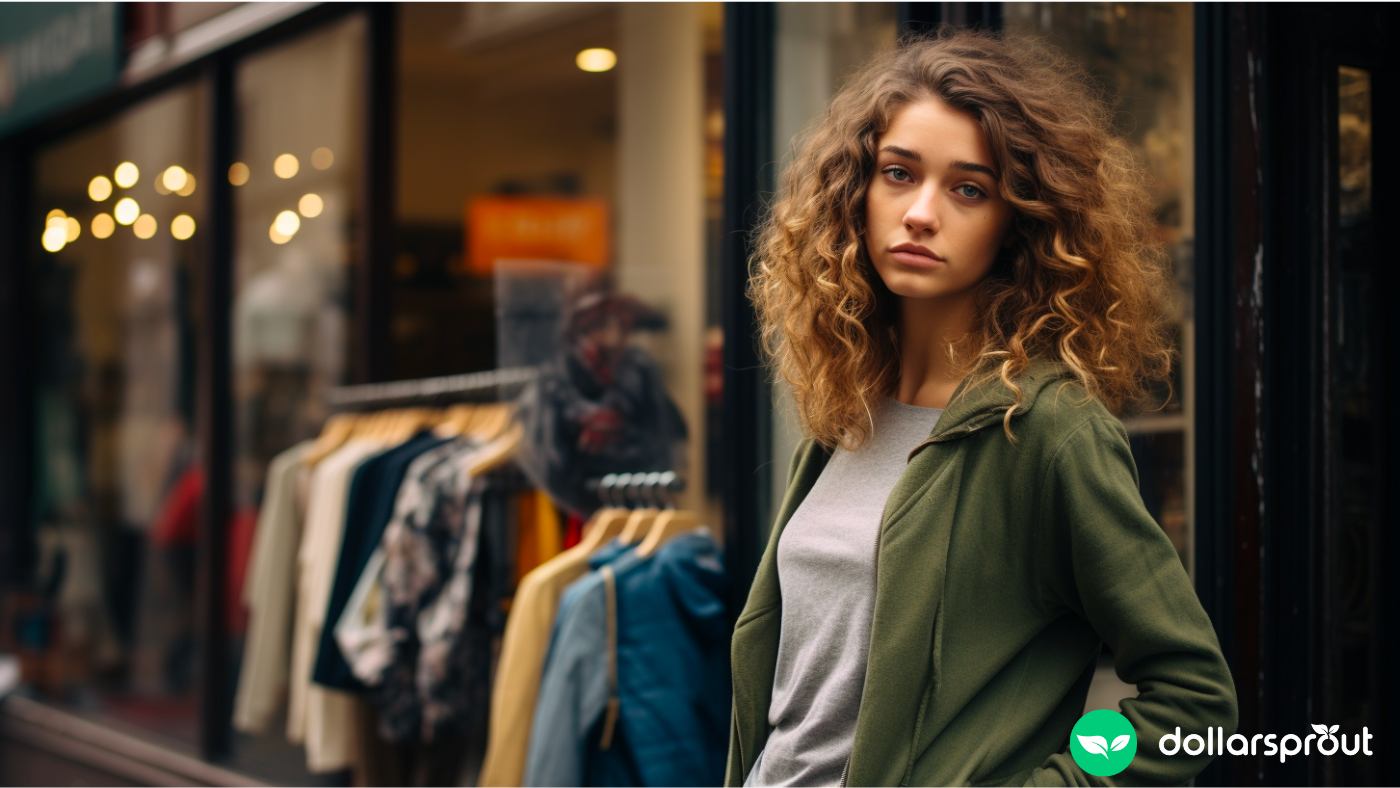I Tried the “No Spend Month” Challenge. Here’s How It Went
Our readers always come first
The content on DollarSprout includes links to our advertising partners. When you read our content and click on one of our partners’ links, and then decide to complete an offer — whether it’s downloading an app, opening an account, or some other action — we may earn a commission from that advertiser, at no extra cost to you.
Our ultimate goal is to educate and inform, not lure you into signing up for certain offers. Compensation from our partners may impact what products we cover and where they appear on the site, but does not have any impact on the objectivity of our reviews or advice.
I’ve never been good at moderation so even giving myself a little fun money meant I was going to overspend. I needed a complete detox from my debit card. So I stopped spending money completely for 30 days.

Our mission at DollarSprout is to help readers improve their financial lives, and we regularly partner with companies that share that same vision. If a purchase or signup is made through one of our Partners’ links, we may receive compensation for the referral. Learn more here.
If you’re in the process of paying off debt, it doesn’t take long to realize how life-altering it can be. Whether it’s giving up takeout or skipping a weekend getaway, these little things make a huge impact when we start to cut them out.
That was hard for me to grasp. When my husband and I started paying off $78,000 of debt, I didn’t want to give up my little luxuries. I thought if I got a few side hustles, I could pay off my debt faster without changing my spending.
After a few months of working 12-hour days, I realized there was no way I could outearn my frivolous spending. I’d maxed out the amount of time I could physically work and we still weren’t seeing the kind of progress we should have. It wasn’t sustainable, and it was never going to get us to debt freedom.
As much as I didn’t want to, I knew I needed to make a budget and get my spending under control in order to stick to it.
But controlling my spending was easier said than done. I’ve never been good at moderation, so even giving myself a little fun money meant I was going to overspend. I needed a complete detox from my debit card.
So I stopped spending money completely for 30 days.
What’s a No-Spend Challenge?
I embarked on what’s widely known as a spending fast or no-spend challenge. It’s a commitment to not spend money on certain items for a specified period of time.
During a no-spend challenge, you keep paying your bills and any other necessary expenses like gas and groceries while cutting out some or all discretionary spending like cable or your Spotify subscription.
I took a look at my bank statements and realized my spending was all over the place. I couldn’t remember making half of the purchases I was looking at. So I decided to cut out all spending that wasn’t essential and put the money I saved toward my debt.
I chose to do it for a month because I wanted to see how significant the change would be on my monthly budget. It was going to be hard, but doable for a few weeks.
Related: How to Save Money: 74 Money-Saving Tips You Can Use Each Month
What I kept buying
What’s considered discretionary spending is unique to your situation. Keeping that in mind, there are a few things that I continued to pay for during my no-spend challenge that others might have cut.
- Fresh produce: I wanted to avoid buying groceries as much as possible to use up the food I already had in my pantry, but I added fresh produce to them for health reasons and to have variety.
- Netflix: I anticipated spending a lot more time at home during my no-spend period. To break up the time, I maintained my Netflix subscription.
- Gym membership: I actually use my gym membership because I’m horrible at motivating myself to work out at home or go for a run. Because I knew I’d use it, I kept it.
- Charity donations: We gave to our church and other local charities the entire time we were paying off our debt. This was something important to us and worth slowing down our debt payoff for.
It’s also worth emphasizing that I still paid for my bills and any expenses that helped me make money. That included gas to get to work and business-related expenses like continuing education.
Related: 10 Minimalist Living Tips That’ll Have You Living Happier with Less
What I stopped buying
I gave up all nonessential purchases, but I wanted to identify my biggest problem areas for impulse spending. This way I could be more intentional with avoiding those categories.
To find them, I looked at my bank statements from the last three months and wrote down the stores and categories that recurred most frequently. I also wrote down what they were costing me every month.
- Take-out coffee: I had a habit of heading to a Starbucks drive-thru anytime I passed one. At $4 per latte, four to five times per week, I was spending at least $75 a month on coffee.
- Eating out: I hated cooking, so I would stop at quick-service restaurants for weekday dinners and sit-down places on the weekends. If I wasn’t eating, I was probably at a happy hour. Eating out five to six days a week was conservatively costing me $200 a month.
- Everything at Target: I believed Target wasn’t a store, it was an experience. I’d go to Target to get out of the house, whether I needed something or not. I estimated I spent at least $125 a month on impulse buys there.
Just these three added up to an extra $400 a month. Other significant expenses I gave up were clothes, makeup, movie tickets, and entertainment expenses.
Along with some other spontaneous purchases, I calculated my no-spend challenge would save around $500. And that’s just my spending. I didn’t keep track of my husband’s spending, but if he’d done it with me we probably could’ve saved an extra $1,000 to put toward debt.
Related: How to Save $1,000 in a Year or Less
What I Learned After 30 Days of Not Spending Money
My first no-spend challenge was excruciating. It challenged my habits and lifestyle in ways I’d never anticipated. I knew it was going to be hard to stay out of Starbucks, but I didn’t realize how awkward I’d feel without that paper cup in my hand.
My no-spend challenge gave me more than just a couple hundred dollars to throw at my student loan debt. It taught me lessons that have improved my spending long after the 30 days ended.
I learned what I truly value spending money on.
Before the no-spend challenge, I spent money on a lot of things I thought were essential to self-care or living my best life. I never stopped to consider that I was making those purchases out of habit, not because I really valued them.
After 30 days of not making any of those purchases, I was able to separate the expenses I truly missed from the ones I didn’t. When I did that, I cut out the things that were just filling time or perpetuating a habit and stopped feeling guilty for the indulgences I did buy.
I developed a new way of thinking about spending.
I also realized that some of my purchases served a purpose that could be fulfilled with free or low-cost alternatives. For example, I didn’t eat out at restaurants because I’m a foodie; I did it because my friends wanted to and I wanted to spend time with my friends.
When I realized that I started hosting people at my house and found that it saves a lot of money. It’s also a much better way to have conversations than yelling across the table at a noisy restaurant.
Now when I think about spending money, I try to find the purpose behind my purchases and see if there’s a way to meet that purpose without opening my wallet.
Related: Are You Addicted to Shopping? Here are 5 Signs You Might Be
Having fewer transactions makes them easier to track.
I hated budgeting before this no-spend challenge. Spreadsheets were confusing, there were too many budgeting apps to learn, and automatic transaction tracking meant I never kept up with it. I found the only way I could stick to a budget was by writing it on paper and tracking my transactions manually.
Before, I had a hard time keeping up with so many transactions. However, during my no-spend challenge, keeping my budget up to date was effortless! I had virtually no transactions to input which meant I could more easily stay on top of it.
And after the 30 days ended I found I didn’t revert back to making as many purchases as I had before. That meant it remained simple to track and maintain my budget.
Getting Started with Your Own No-Spend Challenge
Most of us struggle with frivolous spending habits. Identifying yours can help you save money and pay off debt quicker. If you want to embark on your own no-spend challenge, there are three things you need to do to start on the right foot.
1. Choose your timeframe.
I picked 30 days but that doesn’t mean you have to. You can start with a week, weekends only, or try to accumulate a certain number of no-spend days throughout the month.
Make it something that’s difficult but achievable. Setting a hard start and end date will also motivate you to stick with the challenge and accomplish your goal.
2. Pick your no-spend and exception items.
Giving up all nonessential spending is the fastest way to save a lot of money, but it’s not possible in every situation. Pick your no-spend items based on a single budget category, a group of items you struggle with, or what’s most important to you.
Most months come with an unplanned or unexpected obligation that makes it impossible to not spend money for 30 consecutive days. If you encounter that, whether it’s a dinner with an out-of-town friend or a family potluck, don’t let it deter you from your no-spend challenge. Write down the exception purchase and keep going.
3. Find ways to fill your time.
A surprising number of purchases occur out of boredom. Find free ways to fill your time before you start your challenge so you have a list of activities to go to before you get bored.
You can find free activities at your local library, through Facebook Events, and by volunteering. You can also use the extra time as an opportunity to do things you were too busy to do before, like decluttering your house, starting a side hustle, or hosting a get-together.
Don’t Give Up
But most of all, don’t be discouraged if you slip up. A no-spend challenge simply allows you space to be intentional with your money, confront your impulsive spending behaviors, and rethink your spending habits.
Being intentional with your money and matching your spending to your values creates a strong financial foundation filled with things you truly love and care about.
Related: 52-Week Money Challenge: How to Save $5,000 This Year









